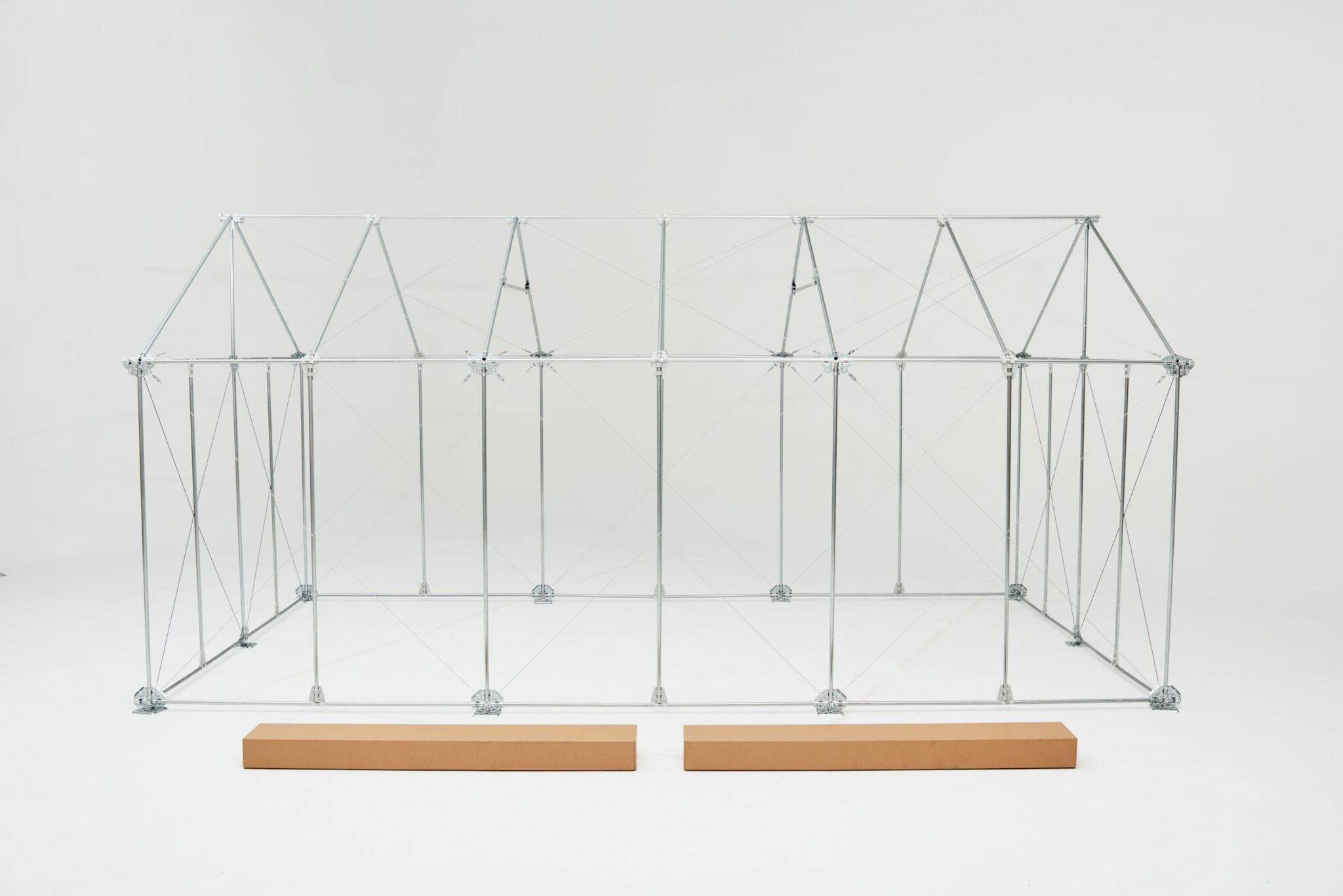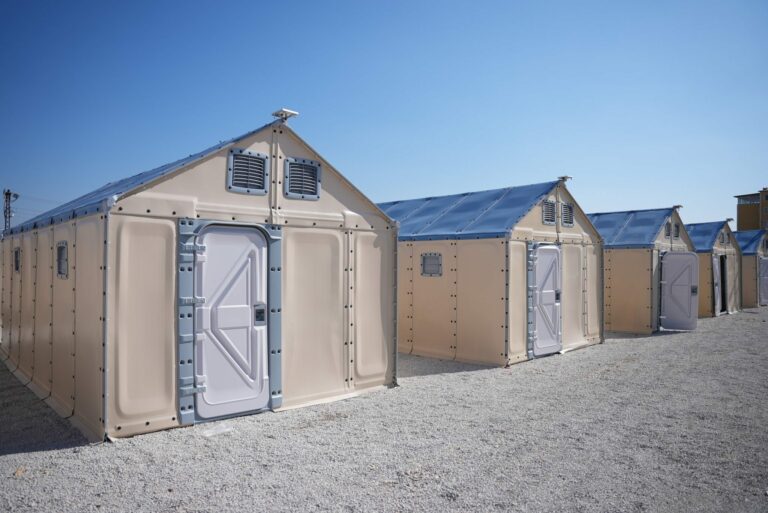PRESS RELEASE 01 February 2021
The Swedish social enterprise Better Shelter releases “Structure” – a low cost emergency shelter which can be upgraded with local materials. Testing of Structure has been conducted with SEEDS in Kerala in India, and with Aga Khan Agency for Habitat (AKAH) in Tajikistan and Afghanistan.
In parallel, Better Shelter is launching a fundraising campaign through which contributors can support forcibly displaced persons by sponsoring an entire or part of a Structure. Better Shelter has delivered 60,000 shelters to 60 countries since 2015, where they serve as temporary homes, clinics and other infrastructure. Structure is Better Shelter’s new shelter type for contexts where local materials are available.
80 million people are displaced today, and the changing climate is expected to force more people into displacement in the coming decades. In 2019 alone, natural disasters triggered 25 million new displacements – the highest recorded figure since 2012. Meanwhile, NGOs and UN agencies must do more with less: the funding available to support humanitarian and development programs is not enough to address the growing needs.
This has led Better Shelter to develop and now release Structure: a low-cost shelter that combines the advantages of a prefabricated modular frame with locally driven shelter programs.
Structure is developed to offer immediate protection in an emergency, but also function as a transitional shelter using local materials. Structure employs the robust steel frame of the Better Shelter and can be transformed into an emergency shelter in a matter of hours by draping it in standard sized tarpaulin sheets. It can be upgraded and made more durable by covering the frame in locally available material – such as bamboo or waddle and daub – and thereby increase its lifespan and resilience among displaced communities.
This in turn makes more shelters available for less. Structure is designed to avoid unnecessary import of materials to countries where local materials can be obtained. Humanitarian partners can thereby hire local labor and contract local suppliers of materials, which in turn stimulates recovery and the local economy after a disaster. Structure can also better align with local shelter strategies, and residents can upgrade them according to local building traditions.
If a family is able to return to their old home, the Structure can either be recycled, repurposed, or be disassembled and stored for use in the events of a new catastrophe. To ensure local suitability, the Better Shelter team piloted Structure together with Aga Khan Agency for Habitat (AKAH) in Tajikistan and Afghanistan, where they serve as infrastructure in the countries’ covid-19 response, and with SEEDS in Kerala in India, where displaced families have upgraded them.
“Structure combines the dependability of a standardized shelter and the adaptability of a local solution. In an ideal world all emergency response would be local. But when assisting the hardest-to-reach individuals in the most difficult types of situations, prefabricated shelter remains the final safety net.”, says Johan Karlsson, Managing Director, Better Shelter.
In parallel, Better Shelter is launching a fundraising campaign where contributors can support displaced communities by funding an entire or a part of a Structure.
“We are very excited to launch a fundraising campaign for Structure”, Johan Karlsson says. “The global humanitarian sector increasingly depends on funding from individuals and the private sector. Not only does this initiative allow our supporters to help displaced families recover and build their own homes, but hopefully it will also direct much needed attention to the plight of refugees and to the global climate crisis.”
In 2021, Better Shelter will scale up and aim to provide Structures for 10, 000 families. The team will continue working with partners, communities and supporters to learn and amplify local building wisdom and traditions – and do it with a minimum of prefabricated materials that can be used for effective response to the greatest challenge of our time.
“The structures by Better Shelter meet the immediate needs of disaster affected communities temporarily displaced from their homes. With increasing number and spread of flood events in India, pre-positioning such shelters will help us meet needs for restoration of shelter, health and education of locally displaced communities much better and sooner”, says Dr. Manu Gupta, Co-founder, SEEDS
“Better Shelter is working with the Aga Khan Agency for Habitat (AKAH) to innovate how to shelter people in the high mountains of Asia who have lost their homes due to natural disasters. We want to stop using tents in these harsh environments and instead upgrade Structure frames to provide winter ready temporary shelters. This will enable the communities we serve to have a better quality of life while we work to provide them with permanent homes.”, says Onno Rühl, General Manager, Aga Khan Agency for Habitat
Press contact
Märta Terne, Head of Communications, Better Shelter
E-mail: marta.terne@bettershelter.org Phone: +46 702 99 18 80
About
Structure is a new initiative by Better Shelter RHU AB – a humanitarian innovation project and social enterprise based in Stockholm, Sweden. Our mission is to improve the lives of refugees by providing temporary, yet safe, homes. The project started in 2010 in collaboration with the Ikea Foundation and the UN Refugee Agency, UNHCR. Since 2015, Better Shelter has delivered more than 60,000 shelters to refugee camps in over 60 countries worldwide. The modular homes are delivered in flat packages and can be set up in a few hours without tools or electricity. Every shelter is equipped with a lockable door and a solar powered lamp. Today, they are not only used as temporary housing, but also as clinics, classrooms and other community-promoting infrastructure.
SEEDS builds the resilience of Indian communities exposed to disaster and climate emergencies by promoting practical solutions that can enhance disaster readiness, response and rehabilitation. Since its beginnings, SEEDS approach has involved grafting innovative technology onto traditional wisdom. This includes designing nature-based solutions that can help adapt to climate change in ecologically sensitive areas as well as to invest in skill building, partnerships and advocacy.
Aga Khan Agency for Habitat (AKAH) works with communities to ensure that the physical settings in which they live are as safe as possible from the effects of climate change and natural disasters while also helping them to be prepared to cope with and respond to disasters that do strike. Beyond making them safe, AKAH ensures people have access to services and opportunities to improve their quality of life, wherever they live. AKAH helps communities not only to prepare for disaster, but to recover and build back better after it strikes. To achieve this AKAH invests in innovation to develop and test practical, affordable and scalable solutions for critical habitat needs, including emergency shelter and permanent housing.




